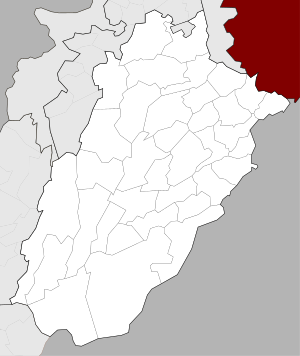Ganweriwal
| گنویريوالا | |
 Ganweriwala Shown within Punjab, Pakistan  Ganweriwala Ganweriwala (Pakistan) | |
| Location | Bahawalpur District, Punjab, Pakistan |
|---|---|
| Region | Cholistan Desert |
| Coordinates | 28°35′56″N 71°9′0″E / 28.59889°N 71.15000°ECoordinates: 28°35′56″N 71°9′0″E / 28.59889°N 71.15000°E[1][2] |
| Type | Settlement |
| Area | 81.5 ha (201 acres)[3] |
| History | |
| Founded | c. 2500 BC |
| Cultures | Indus Valley Civilization |
| Site notes | |
| Archaeologists |
Aurel Stein[4] Mohammed Rafique Mughal Sidra Gulzar[5][6] |
Ganweriwala (Urdu: گنویريوالا Punjabi: گنیریوالا) is an Indus Valley Civilization site in Punjab, Pakistan.[7]
Facts
Ganweriwala is situated near the Indian border on the dry river bed of the Ghaggar-Hakra , now a part of vast desert. It is spread over 80 hectares and comparable in size with the largest sites of the Indus Valley Civilization, such as Mohenjo-daro. But it is not excavated and only identified and it may turn up as top five largest towns of Indus Valley Civilisation.[8]
Significant finds
Although excavation is yet to begin in this site, a stray find of a terrecotta tablet is a significant find. In this seal, a cross legged person (suggested as yogic posture) and a kneeling person below a tree and upon a tree are depicted.[9] Such kneeling persons on tree, particularly in front of a tiger like animal, are shown in tablets or seals found at Harappa (H 163 a), Mohenjadaro (M 309 a) and Kalibangan (K 49a).[9] More recently Sidra Gulzar and Asko Parpola discovered an inscribed tablet from Ganweriwala that may ultimately help to solve the riddle of the Indus Valley script. Despite its degraded condition, one can see the horn of the missing “unicorn bull" to the bottom right, plus seven signs of the Indus script.[10][11]
Importance
It is equidistant from Mohenjo-daro and Harappa, situated in between these two ancient cities. In this aspect, the excavation may provide more information about this ancient civilisation.[8]
See also
References
- ↑ Possehl, Gregory L. Indus age: the beginnings. University of Pennsylvania Press. p. 758. Retrieved 29 April 2017.
- ↑ Journal of Central Asia. Centre for the Study of the Civilizations of Central Asia, Quaid-i-Azam University. p. 156. Retrieved 29 April 2017.
- ↑ Schmidt, Karl J. An Atlas and Survey of South Asian History. Routledge. p. 12. ISBN 9781317476818. Retrieved 29 April 2017.
- ↑ "A Brief Introduction to the Ancient Indus Civilization". www.harappa.com. Retrieved 16 May 2017.
- ↑ "Sidra Gulzar - University of Gothenburg, Sweden". University of Gothenburg. 22 December 2016. Retrieved 16 May 2017.
- ↑ Sidra Gulzar (27 October 2014). "Archaeologik: The forgotten Indus Civilisation". Archaeologik. Retrieved 16 May 2017.
- ↑ Raj Kumar Pruthi (1 January 2004). Prehistory and Harappan Civilization. APH Publishing. pp. 123–. ISBN 978-81-7648-581-4. Retrieved 8 April 2012.
- 1 2 "Ancient Indus Sites". The Indus Civilization. Retrieved 20 June 2012.
- 1 2
- ↑ Sidra Gulzar; Asko Parpola (19 May 2016). "CWA 77". World Archaeology: 7.
- ↑ "New Indus Civilization inscription found - Research portal Tuhat - University of Helsinki". tuhat.helsinki.fi. Retrieved 16 May 2017.